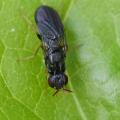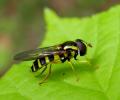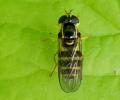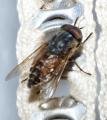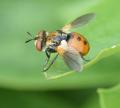Diptera.info :: Identification queries :: Diptera (adults)
Who is here? 1 guest(s)
|
Chaetorellia jaceae?
|
|
| johnes81 |
Posted on 19-10-2016 00:36
|
|
Member Location: Berlin, Germany Posts: 1978 Joined: 15.10.16 |
Hello fellow members, I am new here. I am also new to the study of diptera. I always try to answer my own questions but a second opinion is comforting. I believe that I have made a few photos of Chaetorellia jaceae. I've searched for identification keys and I found a pdf book from the Royal Entomological society. Since I am new to this field, I am not sure about some of the terminology. The keys for C. jaceae are as follows: -anterior (towards head) supra-alar seta (hair) based on a yellow ground -cell cup not extending beyond end of cell bm here is the link to the pdf: http://www.royens..._White.pdf vide page 45 of 138 (page 42 of the actual page) for the keys I do not know what the author means by "cell cup" I think that the seta are based on a yellow ground. I am hoping that an expert can confirm my identification of this species to be C. jaceae. The possible species in Berlin are as follows: Chaetorellia acrolophi Chaetorellia jaceae Chaetorellia loricata I think that this fly is clearly not Chaetostomella cylindrica. I've looked at Terellia tussilaginis and Orellia falcata but I cannot see a match. Thank You very much. johnes81 attached the following image: 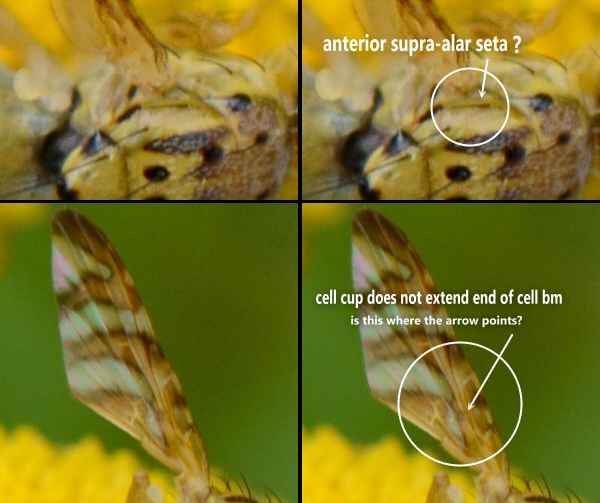 [146.76Kb] |
|
|
|
| johnes81 |
Posted on 19-10-2016 00:54
|
|
Member Location: Berlin, Germany Posts: 1978 Joined: 15.10.16 |
I've attached a photo of the entire species. I understand that the keys in the pdf book are only concerned with separation of two species: C. jaceae and C. loricata. If my assessment is correct, then we can eliminate C. loricata. I do not have keys for C. acrolophi. johnes81 attached the following image: 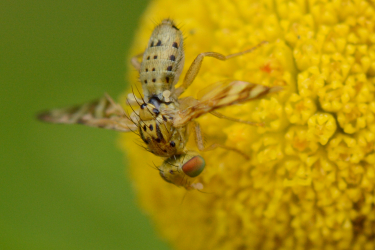 [123.58Kb] |
|
|
|
| johnes81 |
Posted on 24-10-2016 13:44
|
|
Member Location: Berlin, Germany Posts: 1978 Joined: 15.10.16 |
I found a pdf for identification of Iranian/Persian species which isn't helping. http://www.programamoscamed.mx/EIS/biblioteca/libros/articulos/khaghaninia%20and%20Gharajedaghi%202013_2%20.pdf I see C. jaceae but I cannot completely rule out Chaetostomella cylindrica complex. I am getting frustrated  C. jaceae positive id based on accessible keys: body is yellow/brown? yes two pair of ocular setae? yes apical scutellar setae based on black? yes supra-alar seta based on yellow? yes pre- and post-sutural dorsocentral setae present? yes but gena chaetotaxy are not present on this species. I've looked at all of my photos and the wings seem to be curled a bit. this curl obstructs my view of the cup cell which is used to identify jaceae in Britain. I wonder: are there any keys for identifying the various international species? the keys that are accessible only separate native species, which is ridiculous. I am still trying to find keys for C. acrolophi. Anyone know about this species? back to square one? anyone willing to start renaming species and publishing keys? i will start collecting. 
johnes81 attached the following image: 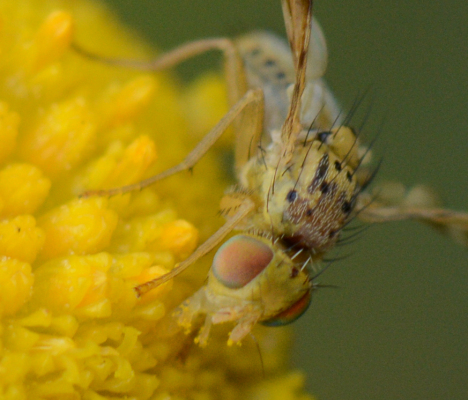 [154.63Kb] Edited by johnes81 on 24-10-2016 13:45 |
|
|
|
| johnes81 |
Posted on 24-10-2016 14:07
|
|
Member Location: Berlin, Germany Posts: 1978 Joined: 15.10.16 |
I've just looked into the flower which seems to be Tanacetum vulgare. Tanacetum vulgare is an Asteraceae flowering plant. based upon this information, the species should be Chaetostomella cylindrica. yet it looks most like Chaetorellia jaceae which is very odd. I think about aphids: a dogwood aphid's host plant is dogwood but I see it on many plants when it moves around. I've seen it on nettle. Thus I wonder if it is possible to see C. jaceae on a different plant? |
|
|
|
| Sundew |
Posted on 25-10-2016 02:12
|
|
Member Location: Berlin and Baden-Württemberg, Germany Posts: 3890 Joined: 28.07.07 |
Wait for Valery, he will surely help you, though males of this group are difficult. In the meantime use the "Forum search" button to get information about the characters of the species under concern - you will find a lot, e.g., that Chaetostomella has no presutural dorsocentral bristles. The most detailed discussions you find in the old threads, so sort in "ascending" order. And why shouldn't the flies feed on Tanacetum nectar? The host plant of the larvae is not necessarily also the only food source for the adults. I saw them on various Asteraceae flowerheads. Regards, Sundew Edited by Sundew on 25-10-2016 02:16 |
|
|
|
| johnes81 |
Posted on 25-10-2016 10:29
|
|
Member Location: Berlin, Germany Posts: 1978 Joined: 15.10.16 |
I mention Tanacetum because experts fail to mention larvae in their material. I was just discussing this with my Wife yesterday. I deduce that the so-called experts are not telling us the truth: host plant only concerns larvae and eggs. By just specifying "host plant" in a work, the author makes it seem as though the species will not be seen on other plants. I am confident with my decision that the plant does not matter unless it concerns larvae. I looked at old threads yesterday after posting. I noticed this person named Valery posting in the threads. I assume that Valery is an expert with Fruit Flies. I imagine Valery is busy and that is understandable. I respect his time. All is good  I have to believe that the species in this photo is certainly C. jaceae. I will give up on this thread now. Thank You Sundew for taking time to weigh in on this topic. I appreciate the help. You live in Berlin? I live in Berlin.  |
|
|
|
| Sundew |
Posted on 25-10-2016 11:59
|
|
Member Location: Berlin and Baden-Württemberg, Germany Posts: 3890 Joined: 28.07.07 |
1. Valery is the top Tephritidae expert who, e.g., identified and sorted the whole collection of the Berlin Naturkundemuseum recently. 2. The Chaetorellia complex is very tricky and needs DNA study, it cannot be easily identified with a simple key. At least one needs to see a lot of specimens, males and females, to estimate the range of variety and overlapping of the characters. 3. To know the host plants is very important. The host plants host the larvae, not the adults (who, however, mainly mate on the host plants before the females oviposit there). Adult flies go where obtainable nectar is offered. 3. None of your photos shows a Centaurea species. |
|
|
|
| johnes81 |
Posted on 25-10-2016 12:26
|
|
Member Location: Berlin, Germany Posts: 1978 Joined: 15.10.16 |
Fruit flies have been intensely studied by scientists all over the globe because they are considered to be an invasive species. I disagree that the species in this photo requires DNA research for identification. You fail to remember that other factors can aid in identification: location, time of year, size, behaviour, food. I may not be an expert here but I'm not an idiot. I am basing my decision on all of the data known about this species. I conclude it to be C. jaceae. I'm okay with this id. I'm moving on  Berlin, August, |
|
|
|
| Sundew |
Posted on 25-10-2016 13:10
|
|
Member Location: Berlin and Baden-Württemberg, Germany Posts: 3890 Joined: 28.07.07 |
Well, fruit flies are not a "species" but a family of about 4,500 species worldwide, some of them invasive and well known, many of them not yet thoroughly studied. Nobody called you an "idiot"; I just wanted to upgrade your understanding of this difficult family, because, as a (now retired) biologist, I have been active in this great forum for 9 years. Enjoy the accumulated knowledge of this community! |
|
|
|
| johnes81 |
Posted on 27-10-2016 21:21
|
|
Member Location: Berlin, Germany Posts: 1978 Joined: 15.10.16 |
Sundew wrote: Well, fruit flies are not a "species" but a family of about 4,500 species worldwide, some of them invasive and well known, many of them not yet thoroughly studied. Nobody called you an "idiot"; I just wanted to upgrade your understanding of this difficult family, because, as a (now retired) biologist, I have been active in this great forum for 9 years. Enjoy the accumulated knowledge of this community! The screen name sundew is not in any list of world renowned experts of Tephritidae. I have no idea why you feel compelled to post here because you offer no new information that is useful for identification of this species. If you want to be agressive: I'd like to see your degree in Entomology. I notice that you say you are retired biologist in this thread but your profile states botanist (plants). Either way, you are not qualified to identify species with keys and photos. I will wait for Valery but he doesn't seem to have an opinion. I am moving on. |
|
|
|
| Nosferatumyia |
Posted on 28-10-2016 02:47
|
|
Member Location: Posts: 3404 Joined: 28.12.07 |
I was offline for a few days and now see the discussion in an arrogant manner. Lieber johnes81: help yourself. It is easy, unless google has banned you. Are you ready to bring your pardons to Lady Sundew? 
Edited by Nosferatumyia on 28-10-2016 02:59 Val |
|
|
|
| Jump to Forum: |


